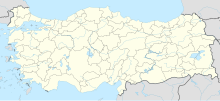Saint Hakob Monastery of Akori
Coordinates: 39 ° 43 ′ 12.4 " N , 44 ° 22 ′ 42.6" E
The Monastery of Saint Hakob of Akori ( Armenian Ակոռիի Սուրբ Հակոբ վանք , Akori Surb Hakob Vank ) was a medieval Armenian monastery in the southeastern part of the Iğdır Province in modern-day Turkey , which was 4.7 km southwest of Akori (now Yenidoğan ), a Village on the northeast slope of Mount Ararat .
architecture
The monastery of Saint Hakob was a cross-shaped building made of black stone with a central dome, which was typical of the Armenian Apostolic Churches of the time. The monastery had eucharistic inscriptions engraved on the walls, dated to the 13th and 14th centuries.
history
According to legend, the Saint Hakob Monastery was founded in 341 by Jacob von Nisibis , the second bishop of Nisibis , who lived in the 3rd and 4th centuries AD. It was built on the north-eastern slope of Mount Ararat in what was then the Masyatsotn canton of the Greater Ayrarat Province in the Kingdom of Armenia ; the larger mountain is called Masis ( Armenian Մասիս ) in Armenian . Some early sources say that Saint Jacob was the name of the monastery while there was also a chapel next door; other sources refer to both as the same site. The monastery is said to have had wooden relics from Noah's Biblical Ark. A strong earthquake took place on Mount Ararat on July 2, 1840, which destroyed the monastery of Sankt Hakob, Arakelots Vank in the neighboring village of Akori and the village itself.
folklore
In early Christian times, according to the historian Faustus of Byzantium , the Armenians assumed the mountain "Ararat" - localized with the Cudi Dağı - in the ancient province of Gordiene (Corduene, Armenian Korduk) as the landing site of the biblical Noah's Ark . According to a legend that emerged around the 12th century, the Armenian mountain Masis , now called Ararat and located in Turkey , was identified with the biblical "Ararat". Since then, the legend has been circulating in Armenia that Noah landed on Mount Ararat and planted the first vines on its slopes when the water drained away. During this time a spring on the Ararat was named after St. Hakob and a church was built in his name. Hakob had climbed the mountain several times in vain in search of the ark. The story of Hakob, known since the 5th century, was transferred from the old landing site of the Ark in Korduk to the local mountain. In the 12th or 13th century, the etymology that the word Akori comes from ark uri , “I planted a vineyard”, solidified .
Individual evidence
- ↑ [1903: Parrot F., Reiszum Ararat, Lpz., 1985]
- ↑ Illustrated dictionary of Taron-Turuberan's monasteries, Eprikyan S., 1953 ( Memento of the original from March 27, 2012 in the Internet Archive ) Info: The archive link has been inserted automatically and has not yet been checked. Please check the original and archive link according to the instructions and then remove this notice.
- ^ The "Christian Armenia" Encyclopaedia, Yerevan 2002, p. 31
- ^ Friedrich Murad: Ararat and Masis: Studies on Armenian antiquity and literature. Carl Winter's Universitätsbuchhandlung, Heidelberg 1901, p. 67 ( at Internet Archive )
- ↑ Hamlet Petrosyan: The Sacred Mountain. In: Levon Abrahamian, Nancy Sweezy (Eds.): Armenian Folk Arts, Culture, and Identity . Indiana University Press, Bloomington 2001, p. 36
